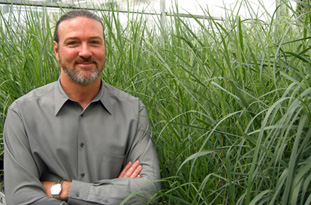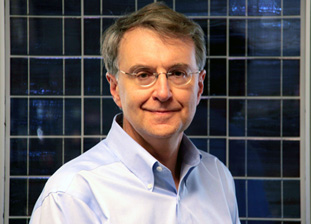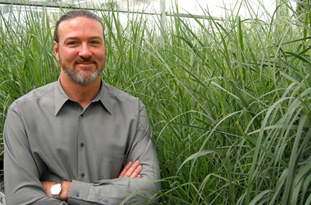 Photo courtesy PNNL via FlickrJet-engine wind turbines, fuel made from big batches of algae, enzymes that trap power plant CO2. Sound seriously far-fetched? They may be. But these concepts are fetching serious investment dollars from the Department of Energy. DOE Secretary Steven Chu — a Nobel Prize-winning inventor himself — has launched a new program dubbed “ARPA-E.” It’s modeled after DARPA (Defense Advanced Research Projects Agency), the Pentagon’s technology-innovation program that was responsible for the internet, cell phones, GPS, and other technical breakthroughs. ARPA-E is doling out multimillion dollar grants to the nation’s most visionary energy innovators — thrill-seeking, over-achieving uber-geeks from start-up companies and universities across America. To offer a glimpse of what they’re up to — and what America’s energy future might look like — we singled out seven of ARPA-E’s 37 recipients. These guys (yes, they’re all guys) are pursuing high-risk endeavors that may never see commercial applications. But if they do, the rewards could be staggering in scope.
Photo courtesy PNNL via FlickrJet-engine wind turbines, fuel made from big batches of algae, enzymes that trap power plant CO2. Sound seriously far-fetched? They may be. But these concepts are fetching serious investment dollars from the Department of Energy. DOE Secretary Steven Chu — a Nobel Prize-winning inventor himself — has launched a new program dubbed “ARPA-E.” It’s modeled after DARPA (Defense Advanced Research Projects Agency), the Pentagon’s technology-innovation program that was responsible for the internet, cell phones, GPS, and other technical breakthroughs. ARPA-E is doling out multimillion dollar grants to the nation’s most visionary energy innovators — thrill-seeking, over-achieving uber-geeks from start-up companies and universities across America. To offer a glimpse of what they’re up to — and what America’s energy future might look like — we singled out seven of ARPA-E’s 37 recipients. These guys (yes, they’re all guys) are pursuing high-risk endeavors that may never see commercial applications. But if they do, the rewards could be staggering in scope.
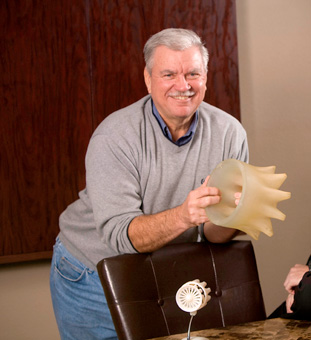
The pioneer: Dr. Walter Presz, founder and Senior Technical Advisor at FloDesign Wind Turbine Corp.
The concept: An entirely new spin on wind energy. With compact blades enclosed in a cylindrical casing, this high-efficiency turbine looks — and operates — like a jet engine. Instead of using energy to create thrust, it uses the thrust of the wind to create energy. An air pump behind the blades pulls in twice as much air as a conventional machine. In wind tunnel experiments, FloDesign’s small-scale prototype generated three times more energy than a standard long-blade turbine of the same size. The encased blades are also quieter and safer for humans — and birds — and the turbine’s compact size means it can be placed along highways, medians and bridges, in suburbs and maybe even cities-all places where bulky conventional wind turbines cannot go.
The payout: $8,325,400.00
The goal: A commercially viable prototype within two years, and ultimately a machine that is 30 percent cheaper than a conventional wind turbine of the same size.
The hurdles: Because of its expensive fiberglass casing, FloDesign turbines require more materials than conventional turbines of the same size — which adds to production costs. And if winds exceed certain speeds, the generator that creates power inside the turbine could overheat. Presz is exploring cheaper materials for mass production, and also designing better air-flow controls for cooling.
The promise: “I’ve worked on propulsion technologies for practically every aircraft in the skies today-from Stealth Bombers and the F16 to the Boeing 737. But this is by far the biggest reward I’ve worked for in my career. The U.S. is way behind Europe and Asia in wind. Now we have the potential to change the entire industry — pushing it from the propeller age into the jet age.”
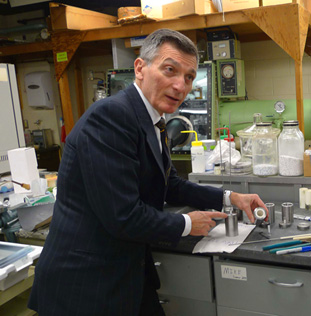 The pioneer: Dr. Donald Sadoway, Professor of Materials Chemistry, Massachusetts Institute of Technology
The pioneer: Dr. Donald Sadoway, Professor of Materials Chemistry, Massachusetts Institute of Technology
The concept: Batteries made of liquid metals. Picture a container of oil and vinegar — these liquids don’t mix, they stratify into two layers. The liquid metals in MIT’s battery stratify too — into three distinct layers (cathode, anode and electrolyte) that interact with each other and conduct electrical current. Conventional batteries made of solid metals are expensive and hard to build big. But liquid batteries could be enormous in size — large enough to store power from wind, solar, and other intermittent sources of energy, and discharge it on demand. They could also be sited at or near the buildings they’re powering, eliminating the need for new transmission lines to urban centers. Don’t expect to see liquid car batteries, though — all that sloshing would disrupt the current.
The payout: $6,949,624.00
The goal: In the next 18 months Sadoway and his team plan to scale up their prototype “from the size of a shot glass to the size of a deep-dish pizza box,” which could provide enough power for a home office. (By 2015, he plans to have a trash barrel-sized liquid battery that would power a small home.) For continuous wind and solar power on the grid, however, the batteries might have to be as big as an eighteen-wheeler, or bigger. It’s too early to put a timeframe on that super-sizing.
The hurdles: Cost, scale, and the laws of physics. A lithium-ion battery — commonly used in small-scale applications like cell phones and laptops — that was big enough to power a house or a neighborhood, would cost more than 1000 times what we now pay for energy from the grid. We need a new approach. The question is whether the laws of physics will cooperate. Energy doesn’t like to be stored; it likes to move. Capturing and containing energy cheaply and on a grand scale “is a seemingly impossible challenge,” said Sadoway, “but that’s what makes it so exciting.”
The promise: “All these people working to improve solar-cell efficiency and wind-turbine performance — that’s great. But it won’t make a difference if you can’t store and discharge that power on demand. Liquid batteries could give us electricity from the sun even when the sun isn’t shining, and from the wind when it isn’t blowing. Storage is everything. It’s a world-changer.”
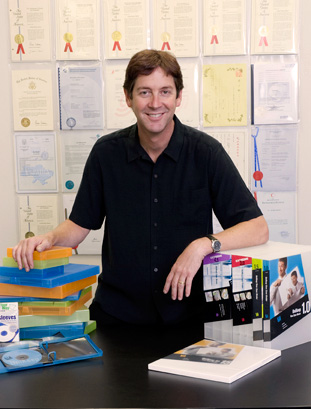
The pioneer: Ross Youngs, founder and CEO Algaeventures Inc.
The concept: An affordable method for mass-producing algae to make alternative fuels, animal feeds, fertilizers, plastics, chemicals, and oils. The trick is the mass production part, because while it’s easy to grow algae, it’s hard to separate these tiny aquatic plants from their watery environment. Algaeventures’ new method uses an absorbent plastic membrane to rapidly “sop up” the water around the algae, making it possible to harvest, de-water, and dry algae on a massive scale using relatively little energy. Youngs’ process could make algae-based biofuel cost-competitive with gasoline.
The payout: $5,992,697.00
The goal: Youngs is currently harvesting algae from water at a rate of 500 liters per hour. His goal is to reach 15,000 liters per hour — for proof of concept — by next year, and 50,000 liters per hour — for commercial applications — by 2012.
The hurdles: Scaling up the volume and bringing down the cost. Youngs is fine-tuning the chemistry of his machine’s permeable membrane, experimenting with new, more absorbent and durable materials and perfecting the weave of the membrane’s tiny plastic threads. He’s also tinkering with ways to move the algae-laden water through the machine in ever-greater volumes.
The promise: “All terrestrial plants evolved from algae. It has been around for billions of years. As a resource it’s incredibly versatile — in theory, it could be used in virtually every application fossil fuels are used for, but without the negative environmental effects. To me, it’s a panacea. It could be as critical to the future of civilization as it was to its formation.”
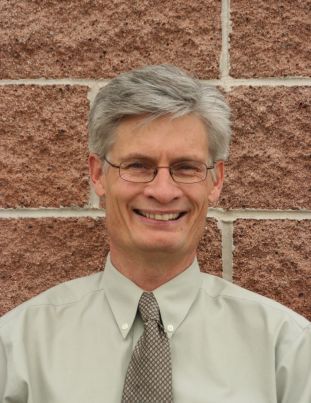 The pioneer: Bruce Lanning, Director of Thin-Film Technologies, ITN Energy Systems, Inc.
The pioneer: Bruce Lanning, Director of Thin-Film Technologies, ITN Energy Systems, Inc.
The concept: Smart windows: glass coated with a thin plastic layer of “electrochromic film” which, when excited by an electrical current, can control the amount of light and heat that passes through. (Think those eyeglass lenses that automatically tint in sunlight, only on a much bigger scale.) On hot August afternoons your office windows could switch from translucent to opaque — shutting out excess light and heat. On bright winter days they’d let the warmth penetrate. Smart controls can tint and un-tint windows automatically — maximizing daylight and minimizing the use of overhead lighting. The energy efficiency benefits could be huge, given that buildings lose 30 to 40 percent of their heat through windows.
The payout: $4,986,249.00
The goal: Scale up the window size, and develop a mass production process that will hold down cost. ITN’s current prototype window measures from 18 to 40 inches; most commercial applications require a 60-inch span. Lanning plans to make a 60-inch window, and predicts full-scale manufacturing of ITN’s plastic-coated smart windows within four years.
The hurdles: Cost and durability. Window-dimming technology has been in development for years. Initially the film was deposited directly onto the glass window, a difficult process to affordably mass-produce. ITN cut costs by depositing the film onto a flexible plastic sheet that can be adhered to glass. Costs have to shrink even further, and the plastic film must prove durable enough to last for decades and withstand the elements. Lanning is also working on dimming speed (how long it takes the window to transition from clear to tinted and back again) and on the color of the tint (rose, yellow, blue, or grey).
The promise: “Energy loss associated with windows totals four quads annually in the U.S. If we switched all the windows in the nation to LowE [the industry standard for highly efficient windows], still two quads of energy would leak out. Smart windows could eliminate all four quads.” [“Quads” is short for quadrillion BTUs of energy. But you knew that.]
The pioneer: Dr. Emanuel Sachs, founder and Chief Technical Officer of 1366 Technologies, Inc.
The concept: Silicon-based solar at the cost of coal. Right now, more than 80 percent of all solar panels sold worldwide are made with high-cost crystalline silicon. Next-gen, thin-film technologies show some promise, but those depend on rare elements such as indium and tellurium. Silica — the principal component of sand and the second most abundant element on earth, after oxygen — could be the ticket to affordable solar. Making solar panels from silicon is wasteful; thin wafers are shaved off large cylindrical columns of refined silicon, which means that half the silicon ends up as dust. With his new “direct wafer” method, Sachs solves the problem by using molten silicon — no sawing needed. The single-step manufacturing process uses much less energy too, which cuts the cost of each wafer by more than 70 percent. If successful, “direct wafers” would open up a market for solar that’s unconstrained by cost or materials.
The payout: $4,000,000.00
The goal: Sachs’s prototype wafers are four inches square with efficiencies of roughly 12 percent. That’s a bit higher than thin film solar, but not as efficient as the 15 to 21 percent range of standard crystalline silicon panels. Sachs plans to produce six-inch square wafers — the commercial standard — with 16 percent efficiency by the end of 2011. Long term, he aims for 21 percent efficiency at one-third the cost of today’s installed silicon-based panels.
The hurdles: Efficiency and mass production. Currently Sach’s molten direct-wafer technology is about 20 to 50 percent less efficient than the standard. The more efficiency you strive for, the more difficult the challenge becomes. In other words, it’s a lot harder to get from 18 to 20 percent efficiency than from 15 to 18. One efficiency-boosting approach Sachs is trying is to introduce textures into the molten crystalline wafers in order to trap more light. He also has to develop commercial-scale production methods. It’s not clear yet that his molten wafer method can make that leap.
The promise: “Sunlight is the original, omnipotent form of energy — fossil fuels themselves are a product of plants grown by sunlight. The question is how to capture this diffuse resource. We are trying to harness the primordial power of nature with the least effort — to find out what nature wants to do and help it on its way.”
The pioneer: Dr. Harry Cordatos, Chemical Engineer and Project Manager at United Technologies
The concept: Equip coal-burning power plants with a filter that uses an artificial enzyme to capture CO2. Along with other air-breathers, we humans use the enzyme carbonic anhydrase to remove CO2 from our bodies. This enzyme reacts with CO2 faster and more efficiently than any chemical known to man. Taking a cue from the human body, Cordatos is incorporating a synthetic version of carbonic anhydrase into a thin polymer membrane which can capture CO2 before it enters smokestacks and channel the pollutant into a different chamber where it can be compressed and piped underground.
The payout: $2,251,183.00
The goal: Perfect the recipe for a synthetic version of carbonic anhydrase that can be placed inside a membrane (or filter), and measure the membrane’s performance in a smokestack environment. Within two years Cordatos hopes to show proof of concept for this process that could capture C02 at two-thirds the cost of prevailing commercial methods.
The hurdles: Knowledge, durability, and cost. We currently use chemicals called “amines” to scrub CO2 from the air in enclosed environments such as submarines and space shuttles (five percent CO2 in the air can be lethal). The amine method could remove 90 percent of CO2 from smokestacks too, but it would raise the cost of electricity by about 80 percent. Carbonic anhydrase is a vastly cheaper alternative, if Cordatos can determine how his synthetic anhydrase will behave inside a smokestack. There’s a high risk that contaminants in the flue gasses could deactivate the enzyme.
The promise: “It’s humbling to see how much better nature is than industry at doing the things we need to do. Over millions of years of evolution, human bodies have developed an extremely efficient method for removing carbon dioxide. This is as good as it gets! It would behoove us to try to mimic that.”
The pioneer: Steve Bobzin, Director of Technology, CERES
The concept: “Super crops” that produce high yields with far less water and nitrogen fertilizer. Adapting technologies from the human genome project, CERES identified traits within sorghum, switchgrass, miscantis, and other biofuel crops that enable the plants to use nitrogen and water more efficiently. Test crops grown in greenhouse laboratories have gotten as much as double the yield per acre for each crop, and the same yield per acre using half the nitrogen. These super crops could produce cheap cellulosic biofuels or be used as a biomass feedstock in power plants — competing with coal as well as oil.
The payout: $4,989,144.00
The goal: To reproduce laboratory yields in the fields. Bobzin is testing four genetic traits in three crops (sorghum, switchgrass and miscantis) on roughly 10-acre plots in Arizona, Georgia, Tennessee and Texas — states with different climate challenges. If the three-year experiment reproduces greenhouse results, they’ll begin testing the seeds on larger plots in more places, putting the innovation on track for commercial-scale development.
The hurdles: Mother Nature. Transitioning from the controlled greenhouse environment to the great outdoors introduces a range of risks: weather, humidity, insects, soil moisture, wind, and mold, to name a few. These stresses could inhibit the genetically tweaked traits from functioning as well as they did in the greenhouse experiments.
The promise: “I have spent my entire career with a desire to do things that would improve life for society, and the promise here is greater than any other innovation I’ve worked for. We could replace oil, we could significantly offset the use of coal with homegrown crops — providing energy security and freeing ourselves from dependence on the Middle East while reinvigorating the rural economy.”
